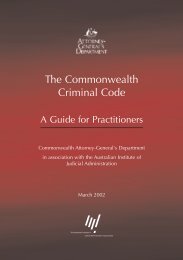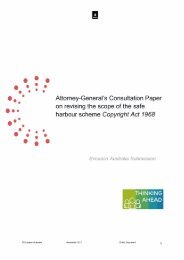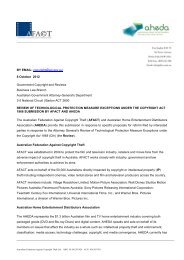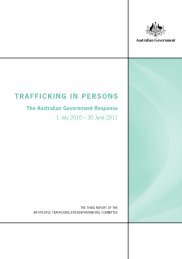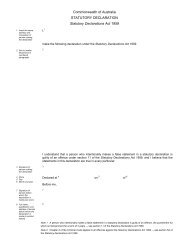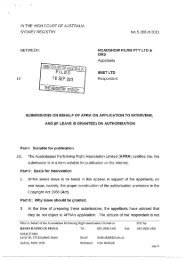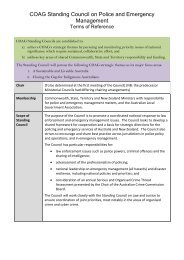Normann Witzleb [PDF 657KB] - Attorney-General's Department
Normann Witzleb [PDF 657KB] - Attorney-General's Department
Normann Witzleb [PDF 657KB] - Attorney-General's Department
You also want an ePaper? Increase the reach of your titles
YUMPU automatically turns print PDFs into web optimized ePapers that Google loves.
67 The reports contain little information on what this defence would add to the defence<br />
that allows privacy invasions where they are ‘required or authorised by or under law’. It<br />
may well be argued that where a person exercises a ‘lawful right’ of defence of person<br />
or property, their conduct will be authorised by or under law. A more significant difficulty<br />
with this defence is, however, that it does not appear to require a balancing between<br />
the plaintiff’s interest in privacy and the defendant’s interest in pursuing his or her legal<br />
rights.<br />
68 This defence lacks a requirement that the defendant’s conduct was necessary and<br />
reasonable. On its face, the defence would allow a person to engage in serious<br />
invasions of privacy provided that that conduct was engaged in with a view to protecting<br />
person or property. For example, an employer may seek to rely on this defence to justify<br />
the installation of hidden cameras in change rooms for the prevention of theft. A<br />
licensed venue may publish on its home page the photos of patrons who have been<br />
banned from the premises for unruly behaviour in order to protect other patrons or<br />
prevent re-entry onto the premises. The VLRC report suggests that defence also<br />
encompasses conduct undertaken for the purpose of prosecuting or defending criminal<br />
or civil proceedings. 115 However, the defence should not provide a blanket permission<br />
on the use of private investigators, regardless of the circumstances giving rise to a<br />
potential civil or criminal dispute and the invasiveness of the conduct engaged in. If the<br />
defence did not contain a reasonableness requirement, it would be open to abuse and<br />
fail to give the plaintiff’s privacy the protection it deserves in the circumstances of each<br />
case.<br />
69 Requiring a balancing of the competing interests underlies the cause of action as a<br />
whole, in particular in relation to countervailing public interests. It would be surprising if<br />
no such balancing were required if the defendant acted in the protection of private<br />
rights. It may be possible that the reference to a ‘lawful right of defence or property’ is<br />
intended to import such a limitation. 116 However, rather than relying on this tautological<br />
expression, it would be preferable if the defence expressly provided the circumstances<br />
in which the defence of the defendant’s private rights allowed for intrusions into the<br />
plaintiff’s privacy. The defence should not be wider than equivalent defences at<br />
common law, eg. in the law of trespass. On that basis, the defendant should be required<br />
to show that there was at least a concrete threat to his right and that the invasion of<br />
privacy was necessary and reasonable for the protection of his or her rights against that<br />
threat. 117 Such a proportionality requirement would ensure that the intended protection<br />
of the defendant’s private rights could not be the basis for egregious privacy invasions.<br />
115 VLRC Report, at [7.156].<br />
116<br />
In Watts v Klaemt, 2007 BCSC 662, 71 BCLR (4th) 362, a neighbourhood dispute, Bruce J disallowed<br />
the defence under the Privacy Act RSBC 1996 c 373, s2(2)(b), which the proposed defence is modelled<br />
upon, where the defendant’s privacy invasions were ‘out of all proportion to the potential danger’<br />
presented by the plaintiff and her family. On the defence of ‘lawful purpose’ in s 17 Harassment Act<br />
1997 (NZ) and whether it imports a proportionality requirement, see also New Zealand Law Commission,<br />
Invasion of Privacy: Penalties and Remedies: Review of the Law of Privacy: Stage 3, Report 113, 2010, at<br />
[5.13]-[5.17].<br />
117 For example, Fontin v Katapodis (1962) 108 CLR 177; [1962] HCA 63.<br />
24


![Normann Witzleb [PDF 657KB] - Attorney-General's Department](https://img.yumpu.com/26247895/24/500x640/normann-witzleb-pdf-657kb-attorney-generals-department.jpg)

